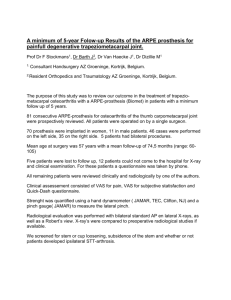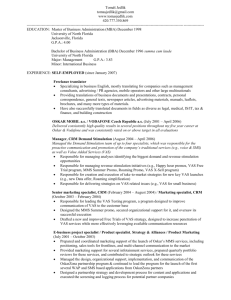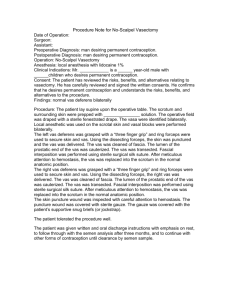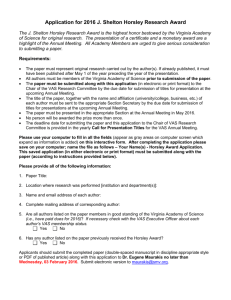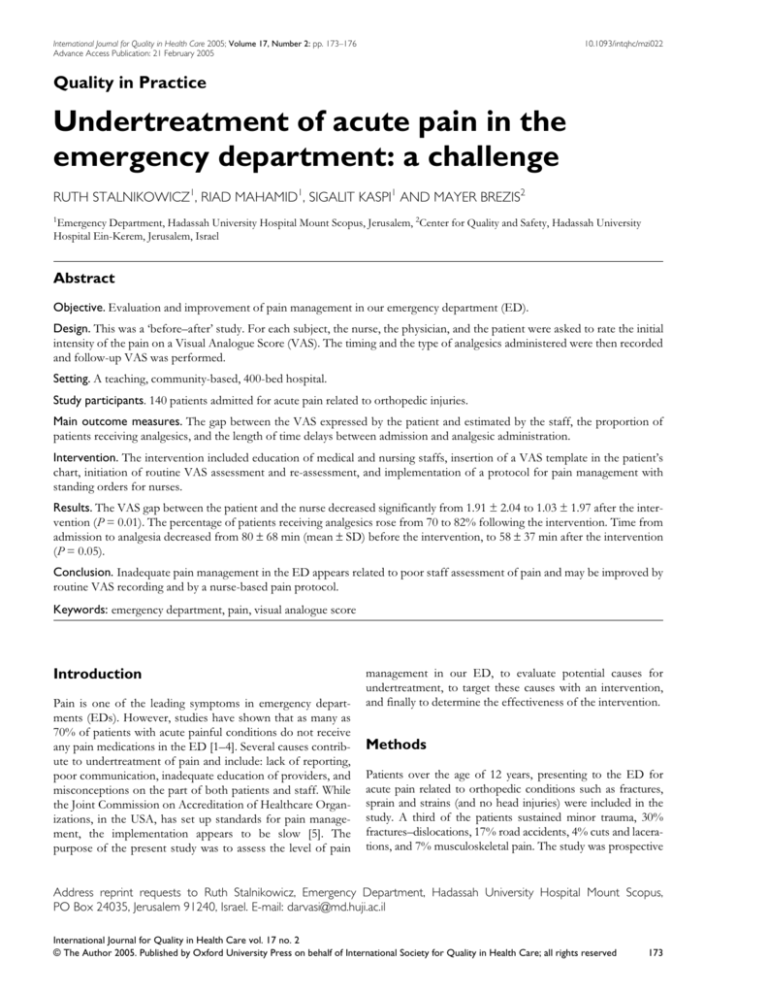
International Journal for Quality in Health Care 2005; Volume 17, Number 2: pp. 173–176
Advance Access Publication: 21 February 2005
10.1093/intqhc/mzi022
Quality in Practice
Undertreatment of acute pain in the
emergency department: a challenge
RUTH STALNIKOWICZ1, RIAD MAHAMID1, SIGALIT KASPI1 AND MAYER BREZIS2
1
Emergency Department, Hadassah University Hospital Mount Scopus, Jerusalem, 2Center for Quality and Safety, Hadassah University
Hospital Ein-Kerem, Jerusalem, Israel
Abstract
Objective. Evaluation and improvement of pain management in our emergency department (ED).
Design. This was a ‘before–after’ study. For each subject, the nurse, the physician, and the patient were asked to rate the initial
intensity of the pain on a Visual Analogue Score (VAS). The timing and the type of analgesics administered were then recorded
and follow-up VAS was performed.
Setting. A teaching, community-based, 400-bed hospital.
Study participants. 140 patients admitted for acute pain related to orthopedic injuries.
Main outcome measures. The gap between the VAS expressed by the patient and estimated by the staff, the proportion of
patients receiving analgesics, and the length of time delays between admission and analgesic administration.
Intervention. The intervention included education of medical and nursing staffs, insertion of a VAS template in the patient’s
chart, initiation of routine VAS assessment and re-assessment, and implementation of a protocol for pain management with
standing orders for nurses.
Results. The VAS gap between the patient and the nurse decreased significantly from 1.91 ± 2.04 to 1.03 ± 1.97 after the intervention (P = 0.01). The percentage of patients receiving analgesics rose from 70 to 82% following the intervention. Time from
admission to analgesia decreased from 80 ± 68 min (mean ± SD) before the intervention, to 58 ± 37 min after the intervention
(P = 0.05).
Conclusion. Inadequate pain management in the ED appears related to poor staff assessment of pain and may be improved by
routine VAS recording and by a nurse-based pain protocol.
Keywords: emergency department, pain, visual analogue score
Introduction
Pain is one of the leading symptoms in emergency departments (EDs). However, studies have shown that as many as
70% of patients with acute painful conditions do not receive
any pain medications in the ED [1–4]. Several causes contribute to undertreatment of pain and include: lack of reporting,
poor communication, inadequate education of providers, and
misconceptions on the part of both patients and staff. While
the Joint Commission on Accreditation of Healthcare Organizations, in the USA, has set up standards for pain management, the implementation appears to be slow [5]. The
purpose of the present study was to assess the level of pain
management in our ED, to evaluate potential causes for
undertreatment, to target these causes with an intervention,
and finally to determine the effectiveness of the intervention.
Methods
Patients over the age of 12 years, presenting to the ED for
acute pain related to orthopedic conditions such as fractures,
sprain and strains (and no head injuries) were included in the
study. A third of the patients sustained minor trauma, 30%
fractures–dislocations, 17% road accidents, 4% cuts and lacerations, and 7% musculoskeletal pain. The study was prospective
Address reprint requests to Ruth Stalnikowicz, Emergency Department, Hadassah University Hospital Mount Scopus,
PO Box 24035, Jerusalem 91240, Israel. E-mail: darvasi@md.huji.ac.il
International Journal for Quality in Health Care vol. 17 no. 2
© The Author 2005. Published by Oxford University Press on behalf of International Society for Quality in Health Care; all rights reserved
173
R. Stalnikowicz et al.
and observational, and included two phases—before and after
an intervention; each designed to collect data on 70 patients
over 3–4 weeks, during 2002. For each subject, the nurse, the
physician, and the patient were asked to rate the initial intensity
of pain on a Visual Analogue Score (VAS) from 1 to 10. The
timing and the type of analgesics administered were then
recorded and follow-up VAS was performed at 30–60 min after
treatment and before discharge from the ED. To explore the
potential contribution of patient misconceptions to undertreatment, 41 patients (from the first phase of the study) were asked
to rank agreement with the following statements, on a scale of 0
(full disagreement) to 5 (full agreement): ‘Analgesics do not
influence pain’; ‘One can easily become addicted to pain killers’;
‘Good patients don’t talk about pain’; ‘It is easier to suffer from
pain than from side effects of analgesics’; ‘Pain complaint
might distract the doctor from my real problem’; and ‘Analgesics should be given only when pain is unbearable’.
After the first phase of the study, the results were presented at staff meetings and discussed with both physicians
and nurses. An intervention was designed as follows:
1. A VAS template was included in each patient’s chart, as a
fifth vital sign.
2. The admitting nurse was instructed to assess VAS on
admission for each patient and to reassess it 30–60 minutes
after treatment.
3. Illustrated posters for patients encouraging pain control
were hung at several places in the ED.
4. A protocol for pain management was developed and posted.
5. Several nurses were appointed as ‘pain trustees’ to promote
the protocol.
6. Standing orders for the use of some analgesics (dipyrone
and acetaminophen) were written for VAS up to 7 (and
most nurses of the ED were authorized by the Head
Nurse to implement these orders).
Nearly 3 months after the initiation of the intervention, the
second phase of the study was conducted with a survey of an
additional 70 patients. These patients were randomly selected
and in all of them an initial VAS was completed. To compare
the results from the two phases, a two-tailed Student’s t test was
used for continuous variables, and a chi-squared test for categorical variables. A paired t test was applied for comparison of
pain ratings between patients, doctors, and nurses. Relationships between variables were examined using Pearson’s correlation and testing. The outcomes variables for quality assessment
were: the proportion of patients with documented VAS, the
proportion of patients receiving analgesics, the length of delay
between admission and analgesic administration, and the gap
between the VAS expressed by the patient and that estimated
by the staff. Data are presented as mean ± standard deviation
(SD). Statistical significance was set at P < 0.05.
Results
Patients enrolled in the two phases of the study were similar
with regard to age, ethnicity, and education (although slightly
more women were included in the post-intervention phase)
(Table 1). No relationship was found between these variables
and the degree of pain assessment or management.
We examined beliefs of patients about pain in the first 41
patients included in the pre-intervention phase. Approximately
one-third of the patients agreed with the first five statements
consistent with attitudes leading to reluctance to report pain.
Two-thirds agreed with the last statement indicating that
patients should not ask for analgesia unless pain is unbearable
(Table 2). No relationship was found between these attitudes
and the demographic variables or whether the patients actually
received analgesics during the current ED visit.
VAS ratings by patients, nurses, and doctors are shown in
Table 3. The average pain scores by patients were slightly lower
after the intervention, both upon admission and after 30–60
minutes. From an average VAS of 7–8 upon admission, the
patients reported a decrease in pain level 30–60 minutes after
analgesics and at discharge. This decrease in pain level was still
slightly higher than their expressed threshold to go home with
(this value expresses the maximal average VAS at which
patients are ready to go home). A significant gap was observed
for VAS ratings by the patient, by the nurse, and by the doctor.
The gap between the patient and the nurse decreased significantly from 1.91 ± 2.04 to 1.03 ± 1.97 after the intervention.
In the first phase of the survey, 70% of patients received analgesics. The mean time from admission to analgesia was 80 ± 68
minutes and nearly 40% of patients with severe pain (VAS
Table 1 Demographic characteristics of the patients in the survey
Phase 1 (before intervention)
Phase 2 (after intervention)
70
33 ± 21
56
29
70
30 ± 20
55
44
48
39
13
35
46
19
...........................................................................................................................................................................................................................
Number of patients
Mean age (years) ± SD
Proportion of non-Jews (%)
Proportion of females (%)
Education
Proportion with <10 years of schooling
Proportion with >10 years of schooling
Proportion with university level education
All comparisons were non-significant.
174
Pain in the emergency department
Table 2 Patients’ attitudes towards pain (n = 41)
Statement
Proportion of
patients agreeing
with statement (%)
.......................................................................... .................................
Analgesics do not influence pain
One can easily become addicted
to pain killers
‘Good patients’ don’t talk about pain
It is easier to suffer from pain
than from side effects of analgesics
Pain complaint might distract the
doctor from my real problem
Analgesics should be given only
when pain is unbearable
37
42
32
42
30
66
above 7) had to wait more than an hour for analgesics. After the
intervention, 82% of patients received analgesics and the time
from admission to analgesia significantly decreased to 58 ± 37
minutes (P = 0.047). After the intervention there was also a
reduction of ‘time from order to administration’ of analgesics
from 14.64 ± 20.13 minutes to 5.38 ± 9.97 minutes (P = 0.008).
The improvement was most prominent for patients with moderate pain (VAS in the range 5–7), for which the nurses used the
standing orders. In this group, the percentage of patients who
received analgesics increased from 50 to 76% (P = 0.05) and the
time from admission to analgesia decreased significantly from
101 ± 66 to 56 ± 32 minutes (P = 0.01). Interestingly, although
analgesics led to 50% decrease in pain intensity, patients who
did not get them reached the same level of pain amelioration
upon discharge from the ED (data not shown).
Discussion
For the purposes of this study, we evaluated orthopedic injuries as pain control in the ED is medically acceptable in these
patients, as opposed to patients with acute abdominal pain
where controversy exists as to the role of pain control [6].
Before the present study, in our ED, the use of VAS for initial
and subsequent evaluation of pain was sporadic and never
recorded. A pain scale was used mainly in patients with acute
chest pain, reflecting, in the eye of nurses and physicians, its
important implications regarding ongoing cardiac ischemia
[5]. Previous studies have documented the underuse of pain
medication in the ED, with only about half of patients receiving analgesics [4], with a range of 30–77% in patients with
fractures [1,7]. A study of the role of ethnicity found that Hispanics and black patients were twice as likely as non-Hispanic
white patients to receive no pain medication in the ED [8]. In
our survey, 70–80% of patients received analgesics, and we
did not identify risk factors for undertreatment: there was no
relationship between age, sex, education, ethnicity, or beliefs
and pain management. Pain improvement without analgesia
could be related to the fact that about a third of the patients in
both groups were treated with mechanical measures (such as
fixation of fractures, reposition of dislocations). While medications are important in pain management, reassurance,
empathy, and explanations—about the condition and its likely
course—are no less important [9].
Another important factor leading to undertreatment of
pain is the tendency for care-givers to underestimate the pain
level experienced by patients [10]. More research is needed to
understand this issue, as statistically significant differences in
pain ratings may not be clinically meaningful [11]. One study
found that nurses underestimated the pain level experienced
by patients more than physicians [12] while in our study,
nurses were closer to patients in their evaluation of pain.
Furthermore, after the intervention, the VAS gap between the
patient and the nurse (but not between the patient and the
doctor) decreased significantly. In addition, after the intervention, time delays were reduced and more patients with moderate
pain received analgesics, probably because nurses were
allowed to give medicines to patients before they were evaluated by a physician. Still it is not clear why it took so long for
patients to receive medication after intervention. The majority
Table 3 VAS assessment by patients, nurses and doctors
VAS (mean ± SD)
Phase 1
(before intervention)
Phase 2
(after intervention)
Statistical significance for
comparison of phases 1 and 2
7.99 ± 2.12
5.11 ± 2.91
4.16 ± 2.17
3.00 ± 2.43
6.09 ± 2.52
5.43 ± 2.11
7.06 ± 1.96
3.77 ± 2.37
3.81 ± 2.34
ND
6.06 ± 2.34
4.01 ± 1.97
P = 0.01
P = 0.01
NS
1.91 ± 2.04*
2.47 ± 1.89*
1.03 ± 1.97*
2.91 ± 1.98*
P = 0.01
NS
............................................................................................................ ................................................ .................................................................
By patients
Upon admission
30–60 minutes after analgesia
At discharge
Threshold to go home
By nurses (upon admission)
By doctors (upon admission)
VAS gap
Between patient and nurse
Between patient and doctor
NS
P < 0.001
*P < 0.001 vs. zero (paired t test).
ND, not determined.
175
R. Stalnikowicz et al.
of ED patients are in fact willing to receive pain medication
from a nurse, before evaluation by a physician [7]. Thus, it
may be reasonable to have registered nurses administer drugs
for pain control before physician evaluation, using a welldefined triage protocol.
In both phases of our study, many patients with severe pain
either did not receive analgesia at all or only after a significant
delay. Since these patients require stronger medications requiring a doctor’s order, underestimation of pain by the physician
could have led to poor pain control. A potential solution to
this problem is the implementation of a nurse-managed, intravenous narcotic policy, shown by Kelly [13] to induce a
remarkable improvement in pain management in the ED.
In conclusion, poor pain management in the ED may be
related to inadequate assessment of pain level by care-givers
and may be improved by initiation of routine VAS recording
and by the implementation of a nurse-based pain protocol.
References
1. Lewis LM, Lasater LC, Brooks CB. Are emergency physicians
too stingy with analgesics? South Med J 1994; 87: 7–9.
2. Selbst SM, Clark M. Analgesic use in the emergency department.
Ann Emerg Med 1990; 19: 1010–1013.
3. Wendel TD. Risk factors for oligoanalgesia in U.S. emergency
departments. Acad Emerg Med 2001; 8: 427–428.
4. Wilson JE, Pendleton JM. Oligoanalgesia in the emergency
department. Am J Emerg Med 1989; 7: 620–623.
176
5. Eder SC, Sloan EP, Todd K. Documentation of ED patient pain
by nurses and physicians. Am J Emerg Med 2003; 21: 253–257.
6. Wolfe JM, Lein DY, Lenkoski K, Smithline HA. Analgesic
administration to patients with an acute abdomen: a survey of
emergency medicine physicians. Am J Emerg Med 2000; 18:
250–253.
7. Beel TL, Mitchiner JC, Frederiksen SM, McCormick J. Patient
preferences regarding pain medication in the ED. Am J Emerg
Med 2000; 18: 376–380.
8. Todd KH, Deaton C, D’Adamo AP, Goe L. Ethnicity and analgesic practice. Ann Emerg Med 2000; 35: 11–16.
9. Ducharme J. Emergency pain management: a Canadian Association
of Emergency Physicians (CAEP) consensus document. J Emerg
Med 1994; 12: 855–866.
10. Guru V, Dubinsky I. The patient vs. caregiver perception of
acute pain in the emergency department. J Emerg Med 2000; 18:
7–12.
11. Todd KH. Clinical versus statistical significance in the assessment of pain relief. Ann Emerg Med 1996; 27: 439–441.
12. Harrison A. Comparing nurses’ and patients’ pain evaluations:
a study of hospitalized patients in Kuwait. Soc Sci Med 1993; 36:
683–692.
13. Kelly AM. A process approach to improving pain management
in the emergency department: development and evaluation.
J Accid Emerg Med 2000; 17: 185–187.
Accepted for publication 2 December 2004

